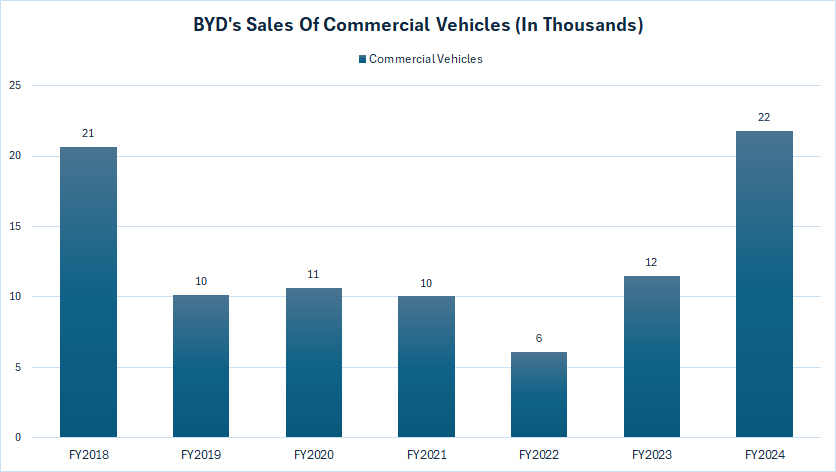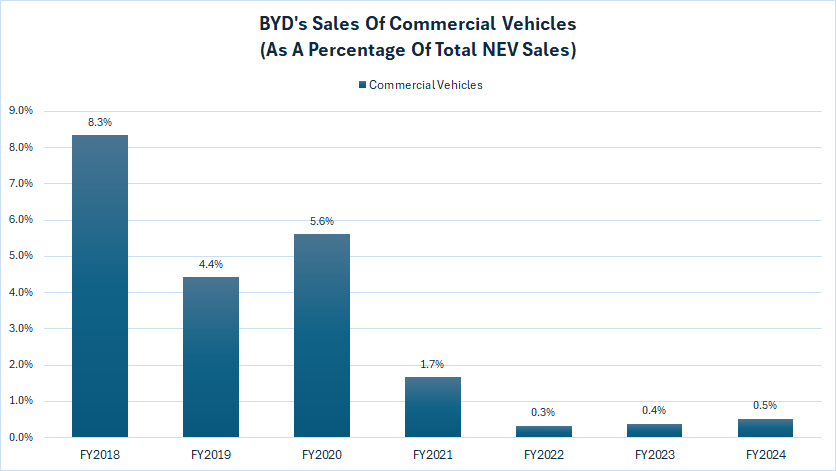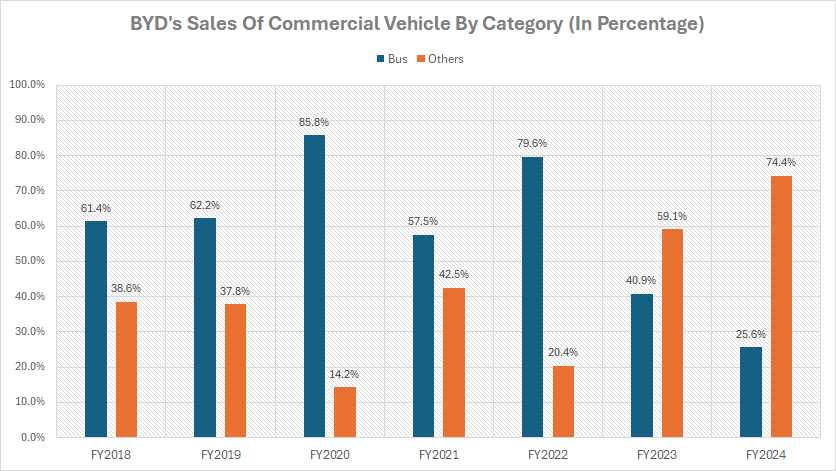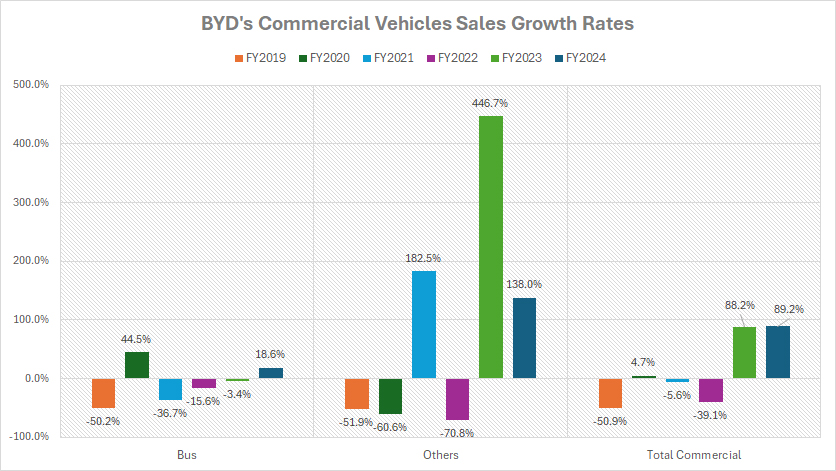
Cruising on highway. Pexels Image.
BYD is known for its innovations in electric vehicles (EVs), particularly through its subsidiary BYD Auto, which has become one of the world’s largest manufacturers of plug-in electric vehicles. The company also produces rechargeable batteries, forklifts, solar panels, semiconductors, and rail transit systems.
This article presents BYD’s commercial vehicle sales volume. For your information, BYD’s commercial vehicle segment falls under the company’s new energy vehicle (NEV) segment which also encompasses the passenger vehicle segment.
Let’s get into the details!
For other key statistics of BYD, you may find more resources on these pages:
Sales
Revenue
Profit Margin
R&D Budget
- BYD vs Tesla: R&D spending
Please use the table of contents to navigate this page.
Table Of Contents
Definitions And Overview
Consolidated Commercial Vehicle Sales
A1. Commercial Vehicle Sales
A2. Commercial Vehicle Sales As A Percentage Of The NEV Volume
Commercial Vehicle Sales By Category
B1. Bus And Other Commercial Vehicle Sales
B2. Percentage Of Bus And Other Commercial Vehicle Sales
Growth Rates
C1. Growth Rates Of Bus And Other Commercial Vehicle Sales
Conclusion And Reference
S1. Insight
S2. References and Credits
S3. Disclosure
Definitions
To help readers understand the content better, the following terms and glossaries have been provided.
Commercial Vehicle Segment: BYD’s commercial segment focuses on the production and sale of commercial vehicles and public transportation solutions.
This segment includes a wide range of vehicles designed for various market needs, such as:
-
Buses and coaches: Electric buses and coaches for public transportation and tourism.
-
Taxis: Electric taxis for urban transportation.
-
Logistics vehicles: Electric trucks and vans for goods transportation and logistics.
-
Construction vehicles: Electric vehicles used in construction sites.
-
Sanitation vehicles: Electric vehicles for waste management and sanitation services.
-
Specialized vehicles: Vehicles for warehousing, port operations, airport services, and mining operations.
BYD’s commercial segment is part of its broader strategy to promote energy-saving, emission reduction, and sustainable urban development. The company aims to transform road traffic from fossil fuels to electricity, contributing to cleaner and greener cities.
Commercial Vehicle Sales
byd-commercial-vehicle-sales
(click image to expand)
BYD’s commercial vehicle segment falls under the larger new energy vehicle (NEV) segment. BYD’s NEV segment also encompasses the passenger vehicle segment. The definition of BYD’s commercial vehicle segment is available here: commercial vehicle segment.
BYD delivered a total of 22,000 commercial vehicles in fiscal year 2024, up by 10,000 vehicles from 12,000 units sold in fiscal year 2023. BYD’s commercial vehicle sales have averaged around 13,000 units annually over the last three years.
Since fiscal year 2018, BYD’s commercial vehicle sales have remained relatively steady, selling a minimum of 10,000 units per year.
However, in fiscal year 2024, the company shipped a notably higher volume of commercial vehicles, totaling 22,000 units, a record figure over the past seven years.
Commercial Vehicle Sales As A Percentage Of The NEV Volume
byd-commercial-vehicle-sales-in-percentage
(click image to expand)
BYD’s commercial vehicle segment falls under the larger new energy vehicle (NEV) segment. BYD’s NEV segment also encompasses the passenger vehicle segment. The definition of BYD’s commercial vehicle segment is available here: commercial vehicle segment.
BYD’s 22,000 units of commercial vehicle sales in fiscal year 2024 made up only 0.5% of the company’s total NEV volume. This ratio has significantly decreased since fiscal year 2018.
In fiscal year 2018, BYD’s commercial vehicle sales made up 8.3% of the company’s total NEV volume. This ratio decreased to 5.6% in 2020 and 1.7% a year later.
The declining sales contribution of BYD’s commercial vehicle segment highlights the substantial growth of the passenger vehicle segment, which accounted for nearly 100% of the total NEV volume as of 2024.
Bus And Other Commercial Vehicle Sales
byd-commercial-vehicle-sales-by-category
(click image to expand)
BYD’s commercial vehicle sales consist of buses and other commercial vehicles. The definition of BYD’s commercial vehicle segment is available here: commercial vehicle segment.
In fiscal year 2024, BYD sold 6,000 buses and delivered 16,000 other commercial vehicles. The average sales of BYD’s buses were 5,000 units per year between fiscal year 2022 and 2024.
On the other hand, BYD sold 8,000 units of other commercial vehicles per year on average from fiscal year 2022 to 2024.
A key observation is that BYD’s sales of other commercial vehicles have significantly exceeded that of buses in recent periods.
The significant increase suggests a broader diversification of BYD in commercial vehicle lineup and an increased focus on addressing specific market segments.
Percentage Of Bus And Other Commercial Vehicle Sales
byd-commercial-vehicle-sales-by-category-in-percentage
(click image to expand)
BYD’s commercial vehicle sales consist of buses and other commercial vehicles. The definition of BYD’s commercial vehicle segment is available here: commercial vehicle segment.
Before 2023, BYD’s buses contributed significantly more to overall sales. In fiscal year 2024, the contribution ratio for buses dropped to 26%, compared to 80% in 2022. In contrast, BYD’s other commercial vehicles contributed 74% of sales in fiscal year 2024, a substantial increase from 20% in 2022.
Growth Rates Of Bus And Other Commercial Vehicle Sales
byd-commercial-vehicle-sales-growth-rates
(click image to expand)
BYD’s commercial vehicle sales consist of buses and other commercial vehicles. The definition of BYD’s commercial vehicle segment is available here: commercial vehicle segment.
BYD’s total commercial vehicle sales exhibited robust growth, increasing by 89% in fiscal year 2024 and 88% in fiscal year 2023. This remarkable recovery followed a sharp decline of 39% two years earlier.
Over the three-year period from 2022 to 2024, the average annual growth rate of BYD’s total commercial vehicle sales reached an impressive 46%.
In terms of bus sales, BYD recorded a 19% increase in fiscal year 2024, reversing a decline of 3.4% in the prior year. This marks a positive shift following three consecutive years of declining bus sales from 2021 through 2023.
However, despite the recent growth in 2024, the average annual growth rate of BYD’s bus sales has remained stagnant since 2021, underscoring the company’s ongoing challenges in expanding this segment.
On the other hand, BYD’s sales of other commercial vehicles have surged dramatically. In fiscal year 2023, sales soared by an extraordinary 447%, following a 71% drop the previous year. This momentum carried into fiscal year 2024, with sales climbing another notable 138%.
Between 2022 and 2024, the average annual growth rate of BYD’s other commercial vehicle sales was an exceptional 171%, reflecting the company’s significant success in this area and highlighting its ability to capture growth opportunities in the broader commercial vehicle market.
Insight
A key takeaway is BYD’s significant shift in the composition of sales: non-bus commercial vehicles now dominate, contributing 74% to total commercial vehicle sales in 2024, compared to just 20% in 2022.
This shift underscores BYD’s ability to capitalize on market opportunities in segments like logistics, construction, and sanitation vehicles, where demand seems to be rising sharply.
It also suggests a strategic pivot or adaptability within the company to expand beyond traditional public transportation solutions, potentially aligning with broader trends in urban electrification and specialized commercial needs
References and Credits
1. All financial figures presented were obtained and referenced from BYD’s monthly production and sales reports published on the company’s investor relations page: BYD Latest Announcement.
2. Pexels Images.
Disclosure
We may use artificial intelligence (AI) tools to assist us in writing some of the text in this article. However, the data is directly obtained from original sources and meticulously cross-checked by our editors multiple times to ensure its accuracy and reliability.
If you find the information in this article helpful, please consider sharing it on social media. Additionally, providing a link back to this article from any website can help us create more content like this in the future.
Thank you for your support and engagement! Your involvement helps us continue to provide high-quality, reliable content.





